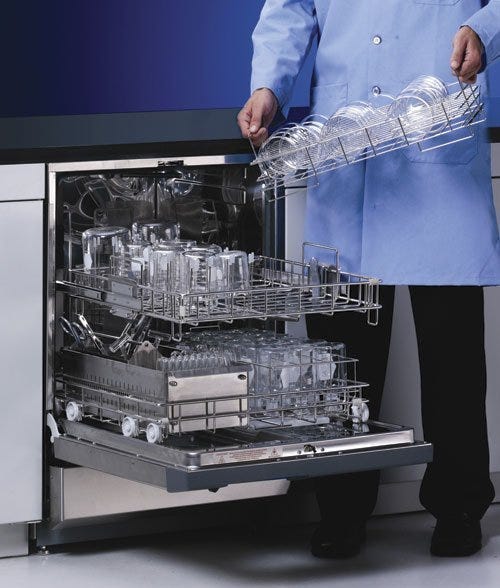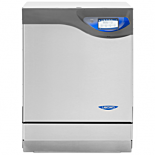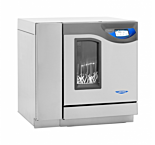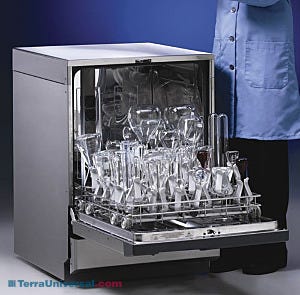Advantages of Using a Labware Washer

The cleaning and sterilization of laboratory, clinical, surgical and compounding equipment are vital to both patient safety and process integrity. In research laboratories, improperly cleaned or sterilized glassware and instruments open the door to unwanted contaminants. Contaminated objects can also endanger laboratory personnel through exposure to mutagenic or toxic substances.
In clinical labs, contamination can lead to erroneous test results, jeopardizing patient treatment regimens or diagnoses. In surgical and pharmaceutical facilities, improper sterilization of equipment or compounding preparations can expose patients to a wide range of microbes and endotoxins. Thus, labs must develop and document washing and sterilization protocols that produce reliable results and ensure safety.
According to a Frost and Sullivan survey published in Lab Manager Magazine, 60% of laboratory budgets is spent on consumable products. Another 30% of the total budget is spent on plasticware, glassware and general laboratory supplies. Unfortunately, the average budget has steadily decreased since early 2010 while the price of consumable goods has increased substantially. Thus, in recent years, laboratory managers have pushed to move towards reusable goods (wherever possible) to compensate for this deficit, making sterilization even more critical to their processes.
While disposable plastic goods, instruments and glassware are a convenient and worry-free option, reusable goods are just as effective and can dramatically reduce costs when properly cleaned and sterilized. They have the added benefit of reducing waste disposal volume and fees.

Several laboratory equipment manufacturing companies have developed innovative solutions for washing labware. Residential and commercial dishwashers fall far short of providing the rigorous cleaning cycles needed to ensure the removal of contaminants found in labs. For instance, the dishwasher in your home has a single pump for both clean and dirty water, and does not contain an inlet water purification system. Thus, contaminants can easily infiltrate the washer.
By comparison, specialized laboratory washers are equipped with dual pumps and stringent purification systems to ensure that only contaminant-free, unrecycled water is used in the cleaning process.
The uncommon shape of laboratory glassware also presents a problem for conventional washers. Erlenmeyer flasks, graduated cylinders, and many other labware products are uniquely shaped to serve a particular function within the lab. Home- and commercial-use washers are not designed to clean of these supplies adequately. Many laboratory washers are outfitted with spindle washers that introduce water directly into narrow-necked labware.

Finally, residential washers typically heat water to between 130°F and 170°F (55°C to 75°C). This temperature range is too low to adequately sanitize reusable labwear. Laboratory washers have a higher heating capability (180°F -200°F), which is more effective for sanitation. Thus, a lab washer provides an excellent option for reducing expenditures on consumable goods without compromising safety.
Indeed, using a labware washer for daily cleaning can actually save your lab a significant amount of money. In the example below, a lab employs an individual to handwash labware three times a week using deionized water and pays them at California’s minimum wage.
Estimated Cost of Hand Washing
- Amount of tap water used per day to hand wash 170 liters
- Time per day to hand wash and rinse 61.4 minutes
- Cost of tap water used per day to hand wash $0.18
- Cost of DI water used per day to hand rinse $6.05
- Cost of labor per day to hand wash/rinse $12.14
- Total cost per year to hand wash $1893.57
Estimated Cost using the FlaskScrubber Laboratory Glassware Washer from Labconco
- Amount of tap water used per day using "Glass" setting 92 liters
- Cost of tap water used per day $0.37
- Cost of tap water used per day (1 pure water rinse) $0.00
- Total cost per day to use the FlaskScrubber $0.37
- Total cost per year to use the FlaskScrubber $57.41
- Total Savings Per Year using the FlaskScrubber $1836.16
From this example, we can see that utilizing a labware washer has the potential to reduce your lab operating cost, as well as significantly reduce your lab water usage and help protect the environment. Keep in mind, the more dishes you wash, the more your lab will save. When combined with savings from wasted reagents and time from improperly hand washed/rinsed glassware, making the switch to a labware washer is a clear-cut choice.
Try before you buy!
DEMO MODELS AVAILABLE
Contact us for Demos, Samples, Brochures and more.
EMAILMon - Fri, 5:30am - 5:30pm PST













